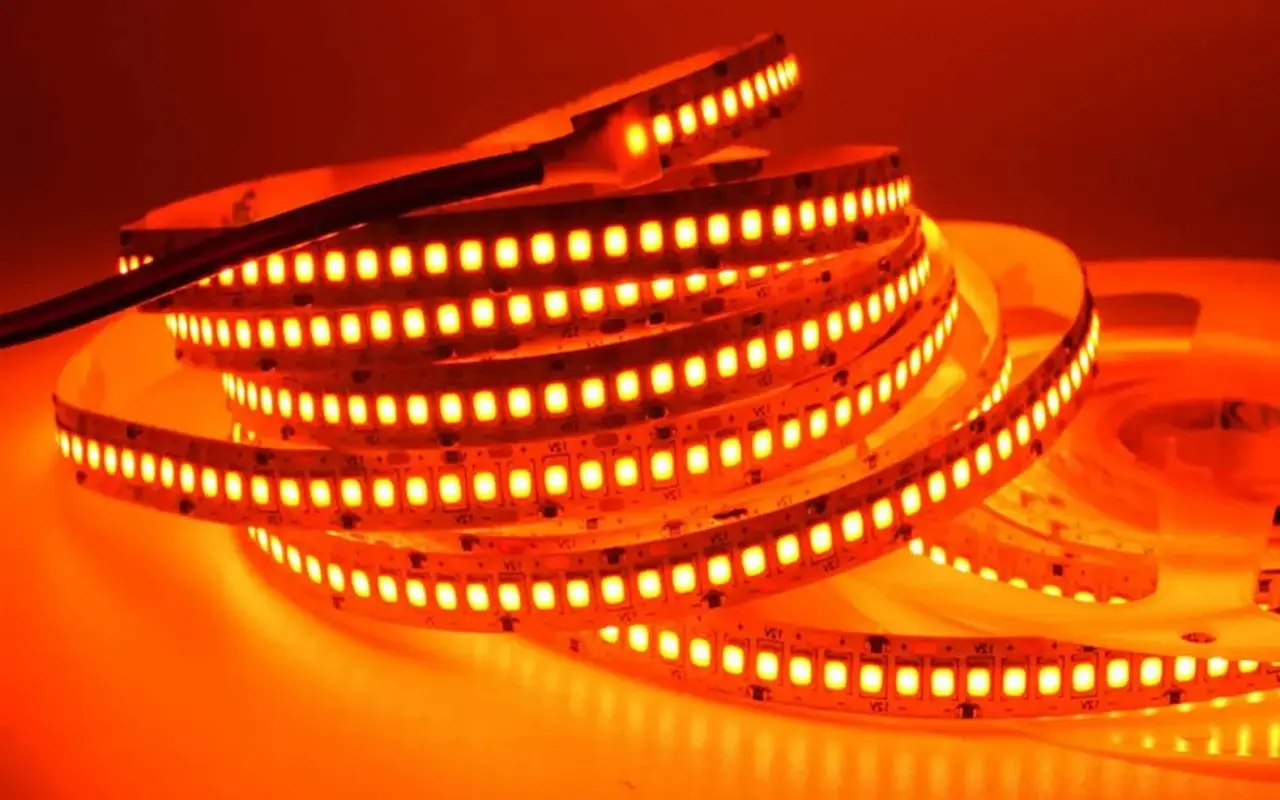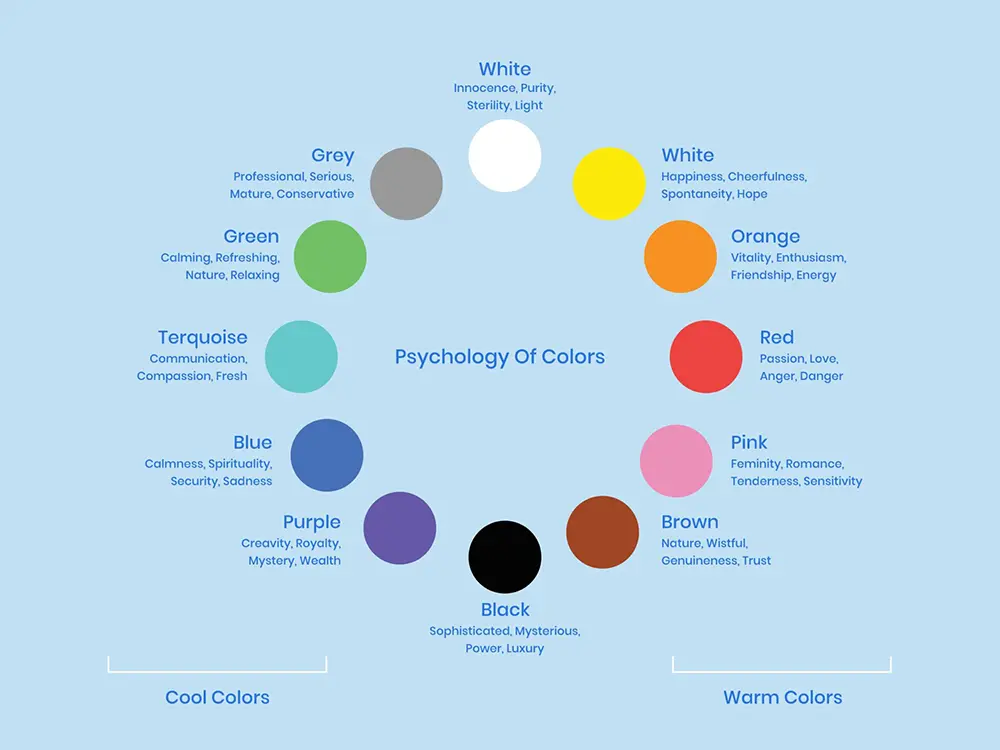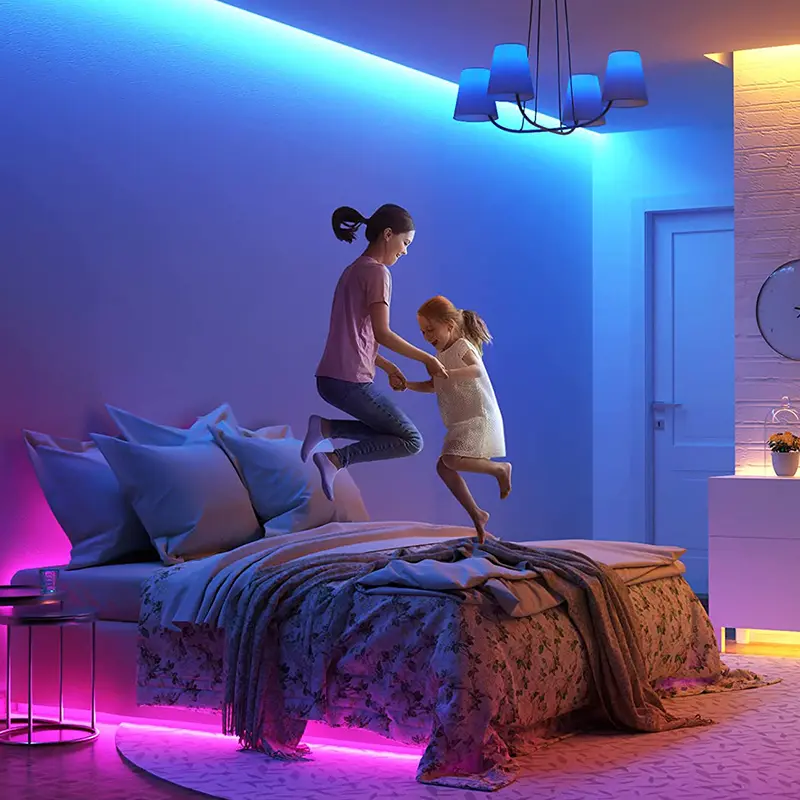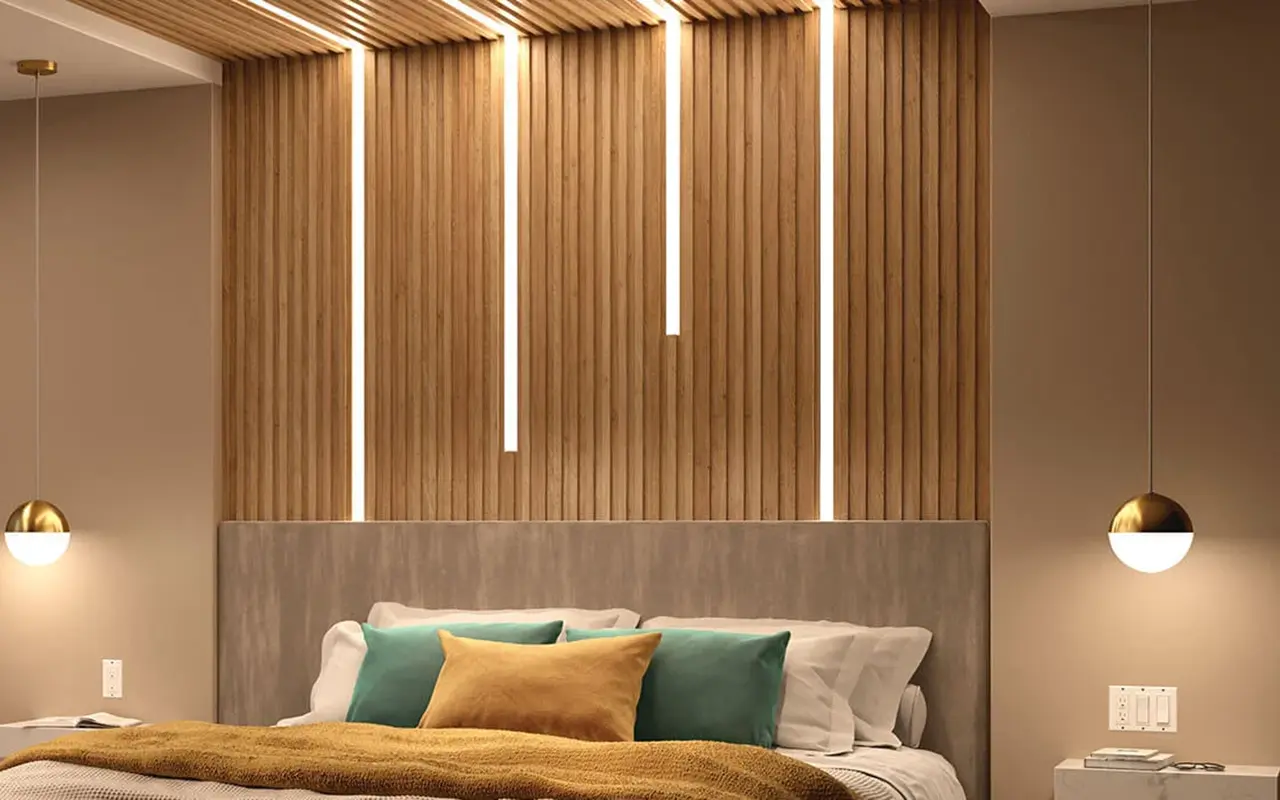Do you struggle with not sleeping well and feeling tired in the morning? Many people today have trouble sleeping well, which can be frustrating. Have you thought about how the LED light in your bedroom affects your sleep and what color light is best for sleep? It’s time to take a closer look at the role of light in your sleep environment.
For better sleep, use a gentle red or amber LED light. These colors help you relax and match your body’s natural sleep pattern. These warm hues are more than just aesthetic choices; they actively interact with your body’s internal processes to create a conducive environment for rest.
But how does this work, and what’s the science behind these specific color choices? Are there more factors to consider in selecting the right LED light for your bedroom? We’re exploring how the color of LED lights can improve your sleep. This includes biology, room design, and common misconceptions. If you want to sleep better, keep reading to find out how changing your lighting can help.
The Connection Between Sleep and Light
Light is not just for seeing. It is very important for our bodies, especially when we sleep. Our relationship with light affects our sleep in profound ways. Let’s discover how LED light colors affect our sleep, it’s really interesting.
Understanding the Sleep-Wake Cycle
The human body’s sleep-wake cycle is a complex process intricately connected to light. Our internal biological clock, called the circadian rhythm, tells us when we feel awake or tired. How does light fit in? The cells in our eyes that detect light, especially blue light, send signals to the brain. These signals affect the production of melatonin, a hormone that helps with sleep.
Our daily use of screens and artificial lighting exposes us to a lot of blue light, especially at night. When we disrupt our natural sleep rhythms, it becomes hard to fall asleep and messes up our sleep patterns.
To find the best sleep solution, it’s important to know how different LED colors impact sleep. It isn’t just about turning off the lights but choosing the right light.
LED Colors and Their Impact
Different colors of LED lights have varied effects on our ability to sleep. Our response to these colors isn’t merely psychological; it’s physiological.
Blue or White Light: These bright colors inhibit melatonin secretion and promote wakefulness. They mimic daylight, tricking the body into thinking it’s time to be active.
Amber Light: It is a calming color that promotes better sleep by encouraging melatonin secretion. It creates a warm atmosphere that doesn’t stimulate the brain. It’s the gentle nudge toward relaxation that your body appreciates.
Red Light: Recognized as the best calming color for sleep, red light ensures minimal disruption to the circadian rhythm. Night lamps or accent lighting can provide tranquility without affecting melatonin production.
When you pick the right LED colors, your surroundings match your body’s natural processes, promoting a peaceful sleep.
Best LED Color for Sleep: Why Choose Red or Amber?
People favor red and amber lights for their warm, relaxing qualities. Red and amber lights do not disrupt your sleep-wake cycle like blue and green lights.
These colors not only look nice, but also help our bodies in different ways. Have you ever felt calm by a campfire or watching a sunset? Those warm colors have a soothing effect. Adding red or amber LED lights to your bedroom has multiple benefits. It improves sleep quality, reduces eye strain, and syncs your body’s rhythm with nature.
Red and amber lights are great for sleep because they boost melatonin and match our body’s rhythm. They also create a soothing atmosphere. If you want a sleep-friendly space for you or your kids, these colors create a dreamy atmosphere. To get better sleep, it’s important to understand how light affects our sleep.
Selecting the Ideal LED Bulb for Sleep
It’s important to choose the right LED bulb for a sleep-friendly space. It’s not just an afterthought. Let’s find out how to choose the right LED bulb and create the perfect sleep atmosphere.
Types of LED Bulbs
Looking for the perfect sleep-enhancing bulb? It’s more complex than grabbing the first one off the shelf. There’s science behind the selection, and it’s worth your attention.
Color Customization: Consider bulbs that offer color customization, particularly those that emit red and amber hues. These colors are designed to help with sleep, emitting zero blue and green light. These bulbs have adjustable settings so you can customize the light to fit your needs.
Brightness Control: Opting for bulbs with brightness control can further enhance your sleep environment. Dimming the lights as bedtime approaches can signal your body that it’s time to wind down.
Smart Bulbs: Many modern LED bulbs integrate with smart home systems, allowing you to program them according to your sleep routine. The bulbs can mimic sunlight by changing color and dimming at specific times.
Setting the Perfect Sleep Atmosphere
The atmosphere of your bedroom plays a significant role in your sleep quality. Think of it as a symphony, where each element contributes to harmony.
Lights: Soft red or amber lights can create a calming environment conducive to a peaceful night’s sleep. They act as the gentle undertone to your sleep symphony.
Furniture: Coupling these lights with cozy furniture like plush pillows and soft blankets adds comfort.
Room Temperature: A cool room temperature, ideally between 60-67°F, is often best for sleep. It helps your body signal that it’s time to rest.
Consider all these factors to create a bedroom that helps you sleep deeply and restfully.
Buying Guide
When purchasing an LED bulb for sleep, here’s a handy checklist to keep in mind:
Check if the light emits blue or green light; if so, it might not be the best choice.
Consider bulbs with adjustable brightness and hue, providing the flexibility you need.
Look for specialized sleep-friendly bulbs or brands known for quality lighting solutions. Reading customer reviews can be a helpful way to gauge user satisfaction.
Designing a Sleep-Friendly Environment
Your sleep environment is about more than just the correct bulb. We can make your bedroom perfect for sleeping by adding things, using smart technology, and being creative.
More Than Just Bulbs
To create a better atmosphere, you can add blackout curtains to block light. You can also use comfortable furniture for physical comfort. Additionally, a well-planned layout can make the most of the space and flow. With the correct LED light, these factors make a good atmosphere for sleeping. A few strategically placed plants can also enhance air quality and add to the calming effect.
Integrazione intelligente
Combinate luci LED e dispositivi smart home per controllare facilmente luminosità e colore. Immaginate di entrare nella vostra camera da letto e che le luci si abbassino lentamente al livello desiderato senza alcuno sforzo. L'automazione può creare un ambiente perfetto per il sonno senza bisogno di modifiche manuali, rendendolo più facile e affidabile.
Idee creative per il fai da te
La vostra camera da letto deve mostrare chi siete e le luci LED possono essere personalizzate in molti modi.
Create un'atmosfera rilassante utilizzando le strisce LED intorno al letto o sulle mensole.
Per l'illuminazione d'accento utilizzate lanterne o lampade appositamente progettate con tonalità morbide e calde.
Adattate le luci ai vostri gusti e osservate come trasformano la vostra esperienza di sonno. Sperimentate diverse collocazioni e combinazioni e integratele persino in opere d'arte.
Salute e benessere grazie a una corretta illuminazione del sonno
Quando si parla di salute e benessere, l'alimentazione e l'esercizio fisico sono spesso al centro dell'attenzione. Avete mai pensato a come la giusta illuminazione per il sonno possa influire sul vostro benessere? Scopriamo come l'illuminazione può migliorare la qualità del sonno, offrire vantaggi medici e persino cambiare la vita attraverso storie di successo reali.
Migliore qualità del sonno
Una buona illuminazione non solo crea l'atmosfera, ma aiuta anche a dormire meglio, con benefici concreti.
Miglioramento della vigilanza: Quando si gode di un sonno di qualità, ci si sveglia più vigili e concentrati. La mente è acuta, pronta ad affrontare le sfide della giornata.
Riposo ristoratore: L'illuminazione LED rossa e ambra può offrire un sonno più riposante allineandosi al ritmo circadiano naturale del corpo. Ciò contribuisce al rilassamento muscolare e al risveglio con una sensazione di freschezza.
Miglioramento dell'umore: Un buon sonno favorisce un umore positivo e la giusta illuminazione può contribuire a ridurre lo stress e l'ansia.
Vantaggi medici
Le luci LED colorate, come il rosso e l'ambra, hanno usi terapeutici che vale la pena di esplorare. Possono migliorare il benessere.
Supporto per l'umore e la salute mentale: Alcuni studi suggeriscono che questi colori influenzano positivamente l'umore e la salute mentale, aiutando in condizioni come il disturbo affettivo stagionale (SAD).
Salute della pelle: La luce LED rossa, in particolare, ha dimostrato di promuovere la salute della pelle stimolando la produzione di collagene, un beneficio inaspettato ma gradito.
Benessere olistico: Gli effetti calmanti delle luci rosse e ambrate si estendono al benessere generale, offrendo un ambiente rilassante che contribuisce al relax e all'armonia.
Storie di successo nella vita reale
Il potere di un'illuminazione adeguata va oltre la teoria. Molte persone hanno scoperto che l'uso di luci LED adatte al sonno può migliorare il loro sonno e il loro benessere generale. Le loro storie, spesso condivise attraverso testimonianze e blog personali, testimoniano il potere trasformativo di una corretta illuminazione. Le persone normali possono risolvere i problemi semplicemente cambiando l'illuminazione delle loro camere da letto. È stimolante e apre gli occhi.
Domande frequenti e malintesi comuni
L'illuminazione del sonno è un argomento complesso con molte sfaccettature da esplorare. Sfatiamo i miti e diamo suggerimenti per casi particolari, con risorse aggiuntive per una maggiore comprensione.
Qual è la migliore luce notturna a colori per i bambini che dormono?
Le luci notturne rosse o ambra sono ideali per i bambini che dormono. Questi colori favoriscono il rilassamento senza disturbare il delicato ciclo del sonno del bambino. Alcuni genitori preferiscono anche il rosa tenue, che offre un effetto delicato e calmante.
La luce LED blu è un buon colore per dormire?
Le luci LED blu brillanti possono disturbare il sonno confondendo l'orologio interno del corpo. Tuttavia, le tonalità di blu più tenui possono avere un effetto calmante se utilizzate correttamente. È consigliabile evitare le luci blu prima di andare a letto come regola generale.
In che modo le luci rosse e gialle migliorano la qualità del sonno?
Le luci rosse e ambrate aiutano a rilassarsi e corrispondono al naturale ciclo sonno-veglia del corpo. I colori caldi aiutano a dormire serenamente perché non influenzano la produzione di melatonina.
La luce LED verde può essere utilizzata per favorire il sonno?
Sì, collegare la luce verde alla tranquillità favorisce un ambiente sereno. È un colore che si trova spesso in natura e può creare un ambiente sereno che favorisce un sonno riposante.
Quali sono le idee creative fai-da-te per utilizzare le luci LED per migliorare il sonno?
È possibile creare un'atmosfera rilassante utilizzando strisce LED, lanterne o lampade personalizzate. Si può realizzare una proiezione del cielo notturno. Si può anche creare un angolo lettura a luce soffusa. Entrambi hanno una luminosità regolabile. Questo vi aiuterà a dormire meglio.
Esistono vantaggi medici nell'utilizzo di luci LED colorate per il sonno?
I ricercatori hanno collegato l'illuminazione a LED colorata, in particolare quella rossa e ambra, a usi terapeutici. Alcuni studi suggeriscono che può aumentare l'umore e la salute mentale, migliorando il sonno e il benessere.
Quali sono i modi migliori per utilizzare le luci LED in una routine che favorisca il sonno?
Per migliorare il sonno, utilizzare luci ambrate la sera e passare a lampadine a luce rossa prima di andare a letto. La combinazione di luci LED e dispositivi domestici intelligenti può migliorare l'ambiente del sonno.
Come posso evitare la dannosa luce blu o verde quando scelgo le lampadine LED per dormire?
Cercate lampadine specializzate per il sonno che non emettano luce blu e verde. Considerate le specifiche del prodotto. Cercate lampadine con regolazione della luminosità e della tonalità. Assicuratevi che contribuiscano a migliorare il sonno.
La luce LED viola fa bene al sonno?
La luce LED viola non è tipicamente associata al miglioramento del sonno. La luce blu intensa è più disturbante, mentre il rosso, l'ambra o il verde tenue sono più tranquillizzanti. È meglio attenersi alle tonalità più consigliate per il sonno.
Quale colore di luce LED vi aiuta a svegliarvi?
Le tonalità più luminose, come il bianco e il blu brillante, stimolano la vigilanza. L'uso di questi colori al mattino può segnalare al corpo che è ora di svegliarsi. In questo modo ci si allinea al proprio ritmo naturale di veglia.
Sfatare i miti
Not all red or amber lights are created equal. To avoid harmful light, it’s important to use bulbs designed for the right wavelengths. To make the best choice, pay attention to details, choose certified products, and ask experts for advice.
Tips for Special Cases
Individual needs vary, and this includes sleep lighting. Here’s how you can cater to those differences:
Children: Consider gentler lights for children’s rooms, as their eyes are more sensitive.
Elderly: Look for options that offer easy control and aren’t too dim, as vision declines with age.
Health Conditions: Certain conditions, like insomnia, may require specific lighting solutions. Consulting with healthcare professionals can help in these cases.
Understanding Specific Colors and Their Effects
In our quest for optimal sleep, color plays a pivotal role. To make informed choices, it’s important to understand how different colors affect sleep. Let’s discover the calmness of red and amber lights. Avoid certain colors. Also, let’s explore other soothing colors that might interest you.
Red and Amber Lights
The warm colors help you sleep and relax. They are inviting and beneficial.
Promoting Relaxation: Red and amber lights are believed to soothe the mind, easing the transition into sleep. This effect is often used in therapy and meditation spaces to enhance calmness.
Aligning with Circadian Rhythm: Unlike other colors, these warm tones align well with the body’s natural sleep-wake cycle, assisting in keeping that rhythm balanced and uninterrupted.
Estetica: Beyond the physiological benefits, these colors add a pleasing ambiance to your bedroom, making it feel cozy and inviting.
Blue and White Lights to Avoid
On the other hand, blue and white lights can disturb sleep. Knowing the reasons can help you make better choices for your sleep space.
Confusing the Biological Clock: These colors send alerting signals to the brain, confusing the body’s internal biological clock and delaying sleep onset.
Inhibiting Melatonin Production: Blue and white light in the evening can inhibit melatonin secretion, the hormone responsible for signaling the body that it’s time to sleep.
Associated with Screen Time: The harmful blue light often comes from electronic devices, emphasizing the need for a screen-free bedroom or utilizing night-mode settings on your gadgets.
Most Relaxing Light Colors
We find other colors with unique benefits expanding beyond red and amber. Here’s a more profound exploration:
Rosso: As discussed, it’s a powerful ally for sleep but also associated with passion and warmth.
Pink: Known for its gentle, calming effect, especially the softer shades that promote feelings of safety and love.
Verde: This natural color is connected to tranquility and is sometimes used in therapy to promote a peaceful environment.
Blu: While bright blue should be avoided, softer shades can be calming if used appropriately.
Strategies and Healthy Habits for Quality Sleep
Creating a sleep sanctuary requires more than just choosing the right light bulbs. To make your favorite colors more relaxing, try using strategies and healthy habits.
When to Use Specific Colors?
Timing matters, especially when it comes to light.
Amber Throughout the House: Consider using amber lights throughout the living areas in the evening. This eases the transition into the night, setting the stage for relaxation.
Red Light Bulbs Before Bedtime: Switching to red light bulbs a few hours before sleep can signal your body that it’s time to wind down, enhancing overall sleep quality.
Calming Habits and Tips
Pairing your LED lights with additional habits amplifies the effects.
Physical Exercise: A balanced exercise routine during the day supports better sleep.
Regular Sleep Schedules: Consistency in sleep timing reinforces your body’s natural rhythm.
Blue Light-Blocking Glasses: When using electronics in the evening, these glasses can reduce blue light exposure, aligning with your lighting choices.
Final Thoughts
Improving sleep with lighting is a nuanced endeavor that goes beyond merely flipping a switch; it demands a detailed, thoughtful approach. Recognizing the subtleties in lighting choices is crucial—for instance, the calming effects of red and amber LED lights contrast sharply with the potentially disruptive influence of blue and white lights. Integrating these insights into your nightly routine, coupled with maintaining healthy habits, can significantly enhance your sleep quality. Lighting should be considered a pivotal element of your sleep environment, capable of transforming your nightly experience into a tranquil journey towards rejuvenation and wellness. By focusing on the “best light color for sleep” and identifying the “most relaxing light color for sleep,” you can create a serene atmosphere conducive to restful sleep. Embracing the right lighting is not just about facilitating sleep; it’s about embarking on a path to overall well-being, where the choice of light color plays a key role in promoting a peaceful, restorative night’s rest.
Discover the key to better sleep with Unitop. We are a top Luci a striscia LED e flex al neon manufacturer in China. We design our high-quality products to improve your well-being with perfect lighting. We have so many years of experience. Have questions or unique requirements? Ci contatti today, and let Unitop guide your journey to a peaceful slumber. Your path to refreshing nights begins here.
Articolo correlato:

Tom è ora il Direttore Vendite di Unitop (Cina) Co., Limited. È stato nella Illuminazione a LED industria dal 2005. È un esperto di vendite e marketing e di gestione della fabbrica. Gli piace il bodybuilding ed è anche un fan sfegatato di Apple! È un lavoratore instancabile e ama imparare e provare cose nuove.
Email: tom@unitopledstrip.com WhatsApp: +86-18680307140








Lascia un Commento
Vuoi partecipare alla discussione?Sentitevi liberi di contribuire!